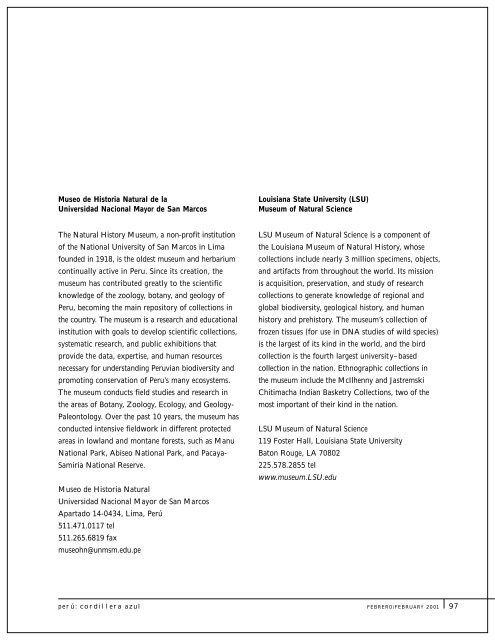RBI 02: Cordillera Azul - Espanol - The Field Museum
RBI 02: Cordillera Azul - Espanol - The Field Museum
RBI 02: Cordillera Azul - Espanol - The Field Museum
Create successful ePaper yourself
Turn your PDF publications into a flip-book with our unique Google optimized e-Paper software.
Museo de Historia Natural de la<br />
Universidad Nacional Mayor de San Marcos<br />
<strong>The</strong> Natural History <strong>Museum</strong>, a non-profit institution<br />
of the National University of San Marcos in Lima<br />
founded in 1918, is the oldest museum and herbarium<br />
continually active in Peru. Since its creation, the<br />
museum has contributed greatly to the scientific<br />
knowledge of the zoology, botany, and geology of<br />
Peru, becoming the main repository of collections in<br />
the country. <strong>The</strong> museum is a research and educational<br />
institution with goals to develop scientific collections,<br />
systematic research, and public exhibitions that<br />
provide the data, expertise, and human resources<br />
necessary for understanding Peruvian biodiversity and<br />
promoting conservation of Peru’s many ecosystems.<br />
<strong>The</strong> museum conducts field studies and research in<br />
the areas of Botany, Zoology, Ecology, and Geology-<br />
Paleontology. Over the past 10 years, the museum has<br />
conducted intensive fieldwork in different protected<br />
areas in lowland and montane forests, such as Manu<br />
National Park, Abiseo National Park, and Pacaya-<br />
Samiria National Reserve.<br />
Museo de Historia Natural<br />
Universidad Nacional Mayor de San Marcos<br />
Apartado 14-0434, Lima, Perú<br />
511.471.0117 tel<br />
511.265.6819 fax<br />
museohn@unmsm.edu.pe<br />
Louisiana State University (LSU)<br />
<strong>Museum</strong> of Natural Science<br />
LSU <strong>Museum</strong> of Natural Science is a component of<br />
the Louisiana <strong>Museum</strong> of Natural History, whose<br />
collections include nearly 3 million specimens, objects,<br />
and artifacts from throughout the world. Its mission<br />
is acquisition, preservation, and study of research<br />
collections to generate knowledge of regional and<br />
global biodiversity, geological history, and human<br />
history and prehistory. <strong>The</strong> museum’s collection of<br />
frozen tissues (for use in DNA studies of wild species)<br />
is the largest of its kind in the world, and the bird<br />
collection is the fourth largest university–based<br />
collection in the nation. Ethnographic collections in<br />
the museum include the McIlhenny and Jastremski<br />
Chitimacha Indian Basketry Collections, two of the<br />
most important of their kind in the nation.<br />
LSU <strong>Museum</strong> of Natural Science<br />
119 Foster Hall, Louisiana State University<br />
Baton Rouge, LA 708<strong>02</strong><br />
225.578.2855 tel<br />
www.museum.LSU.edu<br />
perú: cordillera azul FEBRERO/FEBRUARY 2001<br />
97

















